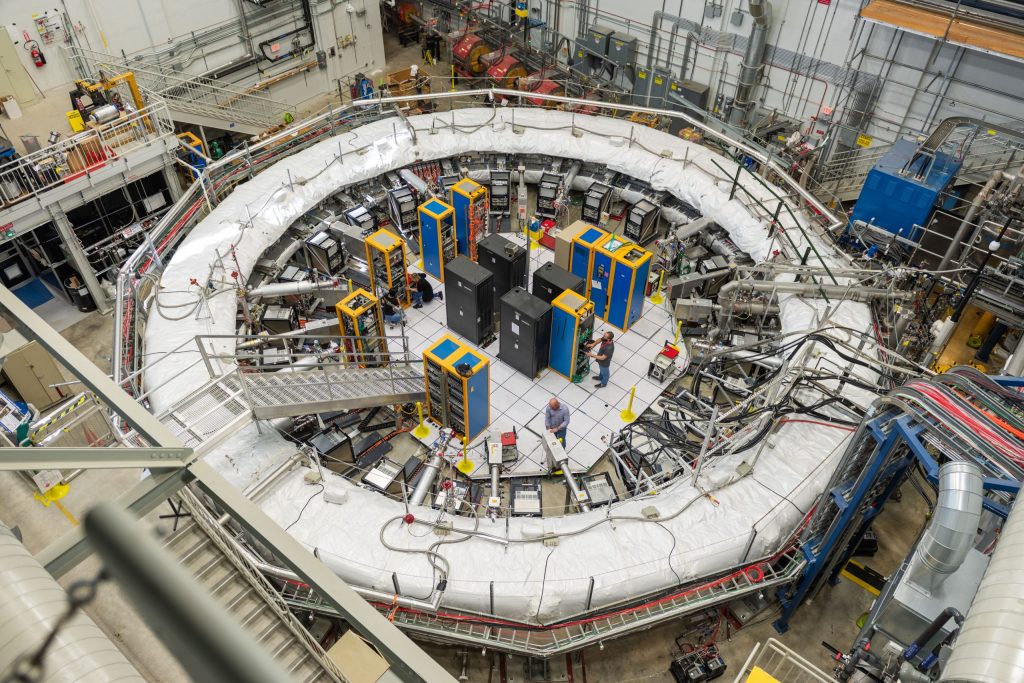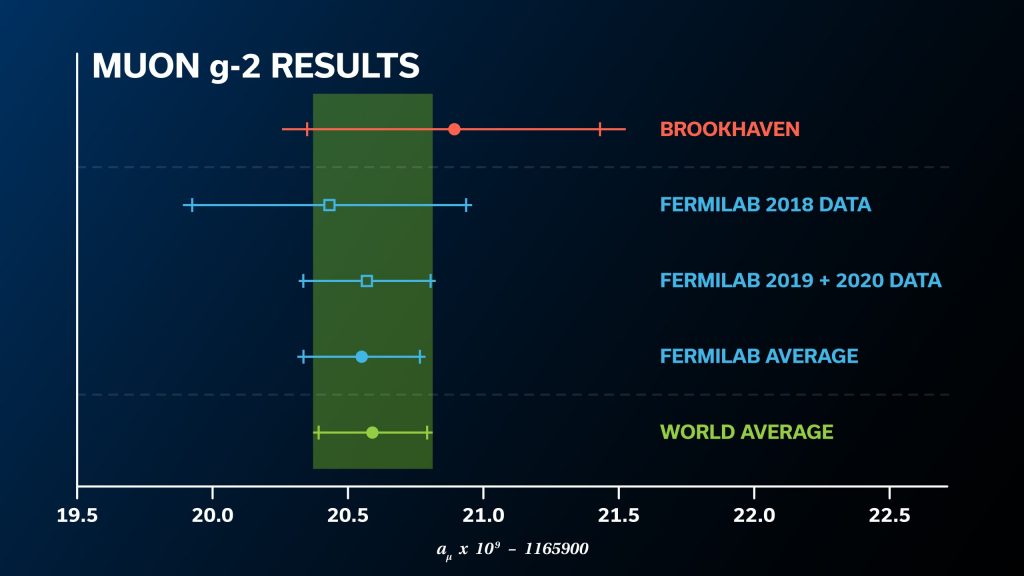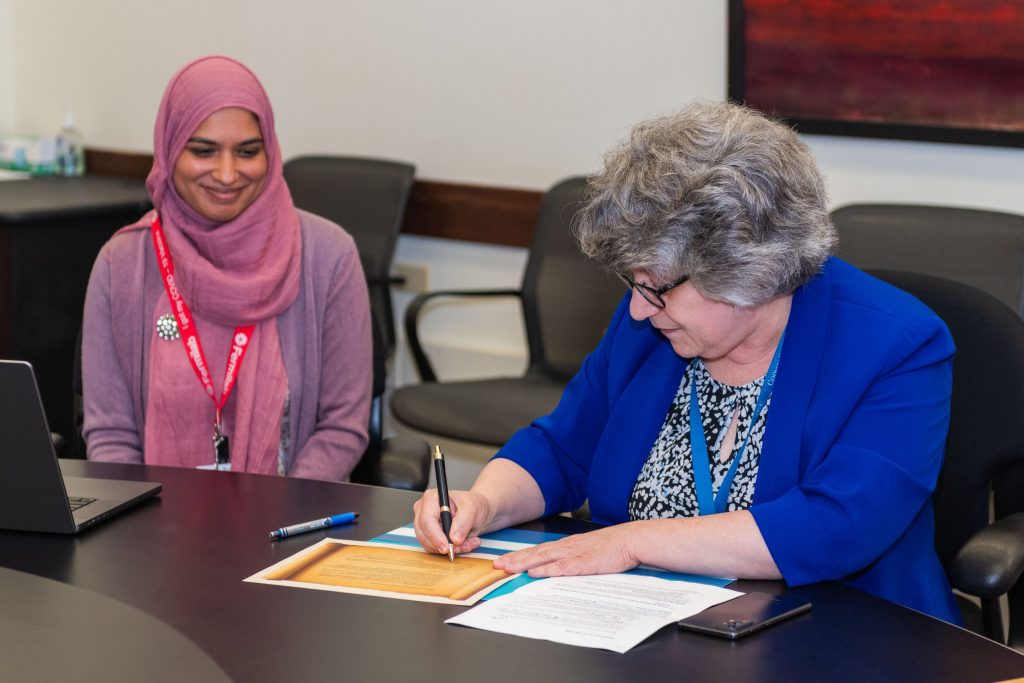Physicists now have a brand-new measurement of a property of the muon called the anomalous magnetic moment that improves the precision of their previous result by a factor of 2.
An international collaboration of scientists working on the Muon g-2 experiment at the U.S. Department of Energy’s Fermi National Accelerator Laboratory announced the much-anticipated updated measurement on Aug. 10. This new value bolsters the first result they announced in April 2021 and sets up a showdown between theory and experiment over 20 years in the making.
“We’re really probing new territory. We’re determining the muon magnetic moment at a better precision than it has ever been seen before,” said Brendan Casey, a senior scientist at Fermilab who has worked on the Muon g-2 experiment since 2008.

The announcement on Aug. 10, 2023, is the second result from the experiment at Fermilab, which is twice as precise than the first result announced on April 7, 2021. Photo: Ryan Postel, Fermilab
Physicists describe how the universe works at its most fundamental level with a theory known as the Standard Model. By making predictions based on the Standard Model and comparing them to experimental results, physicists can discern whether the theory is complete — or if there is physics beyond the Standard Model.
Muons are fundamental particles that are similar to electrons but about 200 times as massive. Like electrons, muons have a tiny internal magnet that, in the presence of a magnetic field, precesses or wobbles like the axis of a spinning top. The precession speed in a given magnetic field depends on the muon magnetic moment, typically represented by the letter g; at the simplest level, theory predicts that g should equal 2.
The difference of g from 2 — or g minus 2 — can be attributed to the muon’s interactions with particles in a quantum foam that surrounds it. These particles blink in and out of existence and, like subatomic “dance partners,” grab the muon’s “hand” and change the way the muon interacts with the magnetic field. The Standard Model incorporates all known “dance partner” particles and predicts how the quantum foam changes g. But there might be more. Physicists are excited about the possible existence of as-yet-undiscovered particles that contribute to the value of g-2 — and would open the window to exploring new physics.
The new experimental result, based on the first three years of data, announced by the Muon g-2 collaboration is:
g-2 = 0.00233184110 +/- 0.00000000043 (stat.) +/- 0.00000000019 (syst.)
The measurement of g-2 corresponds to a precision of 0.20 parts per million. The Muon g-2 collaboration describes the result in a paper that they submitted today to Physical Review Letters.
With this measurement, the collaboration has already reached their goal of decreasing one particular type of uncertainty: uncertainty caused by experimental imperfections, known as systematic uncertainties.
“This measurement is an incredible experimental achievement,” said Peter Winter, co-spokesperson for the Muon g-2 collaboration. “Getting the systematic uncertainty down to this level is a big deal and is something we didn’t expect to achieve so soon.”

Due to the large amount of additional data that is going into the 2023 analysis announcement, the Muon g-2 collaboration’s latest result is more than twice as precise as the first result announced in 2021. Image: Muon g-2 collaboration
While the total systematic uncertainty has already surpassed the design goal, the larger aspect of uncertainty — statistical uncertainty — is driven by the amount of data analyzed. The result announced today adds an additional two years of data to their first result. The Fermilab experiment will reach its ultimate statistical uncertainty once scientists incorporate all six years of data in their analysis, which the collaboration aims to complete in the next couple of years.
To make the measurement, the Muon g-2 collaboration repeatedly sent a beam of muons into a 50-foot-diameter superconducting magnetic storage ring, where they circulated about 1,000 times at nearly the speed of light. Detectors lining the ring allowed scientists to determine how rapidly the muons were precessing. Physicists must also precisely measure the strength of the magnetic field to then determine the value of g-2.
The Fermilab experiment reused a storage ring originally built for the predecessor Muon g-2 experiment at DOE’s Brookhaven National Laboratory that concluded in 2001. In 2013, the collaboration transported the storage ring 3,200 miles from Long Island, New York, to Batavia, Illinois. Over the next four years, the collaboration assembled the experiment with improved techniques, instrumentation and simulations. The main goal of the Fermilab experiment is to reduce the uncertainty of g-2 by a factor of four compared to the Brookhaven result.
“Our new measurement is very exciting because it takes us well beyond Brookhaven’s sensitivity,” said Graziano Venanzoni, professor at the University of Liverpool affiliated with the Italian National Institute for Nuclear Physics, Pisa, and co-spokesperson of the Muon g-2 experiment at Fermilab.
In addition to the larger data set, this latest g-2 measurement is enhanced by updates to the Fermilab experiment itself. “We improved a lot of things between our first year of taking data and our second and third year,” said Casey, who recently finished his term as co-spokesperson with Venanzoni. “We were constantly making the experiment better.”
The experiment was “really firing on all cylinders” for the final three years of data-taking, which came to an end on July 9, 2023. That’s when the collaboration shut off the muon beam, concluding the experiment after six years of data collection. They reached the goal of collecting a data set that is more than 21 times the size of Brookhaven’s data set.
Physicists can calculate the effects of the known Standard Model “dance partners” on muon g-2 to incredible precision. The calculations consider the electromagnetic, weak nuclear and strong nuclear forces, including photons, electrons, quarks, gluons, neutrinos, W and Z bosons, and the Higgs boson. If the Standard Model is correct, this ultra-precise prediction should match the experimental measurement.
Calculating the Standard Model prediction for muon g-2 is very challenging. In 2020, the Muon g-2 Theory Initiative announced the best Standard Model prediction for muon g-2 available at that time. But a new experimental measurement of the data that feeds into the prediction and a new calculation based on a different theoretical approach — lattice gauge theory — are in tension with the 2020 calculation. Scientists of the Muon g-2 Theory Initiative aim to have a new, improved prediction available in the next couple of years that considers both theoretical approaches.
The Muon g-2 collaboration comprises close to 200 scientists from 33 institutions in seven countries and includes nearly 40 students so far who have received their doctorates based on their work on the experiment. Collaborators will now spend the next couple of years analyzing the final three years of data. “We expect another factor of two in precision when we finish,” said Venanzoni.
The collaboration anticipates releasing their final, most precise measurement of the muon magnetic moment in 2025 — setting up the ultimate showdown between Standard Model theory and experiment. Until then, physicists have a new and improved measurement of muon g-2 that is a significant step toward its final physics goal.
The Muon g-2 collaboration submitted this scientific paper for publication.
This seven-minute video provides additional information about muons and the new result by the Muon g-2 collaboration.
Here is the recording of the scientific seminar held on Aug. 10, 2023.
The Muon g-2 experiment is supported by the Department of Energy (US); National Science Foundation (US); Istituto Nazionale di Fisica Nucleare (Italy); Science and Technology Facilities Council (UK); Royal Society (UK); European Union’s Horizon 2020; National Natural Science Foundation of China; MSIP, NRF and IBS-R017-D1 (Republic of Korea); and German Research Foundation (DFG).
Fermilab is America’s premier national laboratory for particle physics research. A U.S. Department of Energy Office of Science laboratory, Fermilab is located near Chicago, Illinois, and operated under contract by the Fermi Research Alliance LLC. Visit Fermilab’s website at https://www.fnal.gov and follow us on Twitter @Fermilab.
The DOE Office of Science is the single largest supporter of basic research in the physical sciences in the United States and is working to address some of the most pressing challenges of our time. For more information, visit https://science.energy.gov.
Researchers from the U.S. Department of Energy’s Fermi National Accelerator Laboratory are experts in making microelectronics and data processing more efficient and powerful. This collective knowledge comes from decades of developing giant detectors for high-energy physics.
On July 17, two distinguished guests joined researchers at Fermilab to sign the Energy Efficiency Scaling for 2 Decades pledge, or EES2. These guests include Tina Kaarsberg, a program manager from the DOE’s Office of Energy Efficiency and Renewable Energy; and Sadasivan Shankar, research technical manager from DOE’s SLAC National Accelerator Laboratory.
“Fermilab has emerging core competencies in circuits, architectures and edge algorithms,” said Lia Merminga, Fermilab’s director. “Our lab has been designing low-power circuit solutions for advanced scientific instrumentation, detectors, accelerators and more for four decades.”
The EES2 pledge
Since the 1940s, computational power has grown exponentially. This growth has largely been sustained according to Moore’s law, which observes the number of components per integrated circuit doubling every year. But current computing technologies are not efficient enough to meet society’s demands to produce and process more data.
Fermilab has become the 48th organization to sign the EES2 pledge. The EES2 pledge seeks to improve the efficiency of electronics and support American manufacturing. Led by the DOE’s Advanced Materials and Manufacturing Office, this pledge aims to set the semiconductor industry on the path to double energy efficiency every two years. It also looks to increase the competitiveness of semiconductor manufacturers and strengthen clean energy supply chains in America.

Farah Fahim, the division head for Fermilab’s Microelectronics Division (left) and Lia Merminga, Fermilab’s director, sign the EES2 pledge. Photo: Ryan Postel, Fermilab
To meet this goal, four working groups will participate in EES2 workshops and contribute a roadmap.
“This EES2 pledge is a win for the environment without compromising science,” said Shankar. “Technological innovations are needed to enable this paradigm of energy-efficient computing since more and more energy is spent on analyzing data. Fermilab can play an invaluable role in extending the premise of intelligent sensing to applications beyond particle detectors.”
Fermilab’s emerging technologies
During the visit, guests toured Fermilab’s facilities to see how the lab strives to improve efficiency in computing and detectors. At the start of the tour, visitors listened to talks about driving innovation.
Researchers demonstrated a few ways AI-on-chip is used to advance Fermilab’s mission. They shared how an artificial intelligence algorithm compresses data for the Compact Muon Solenoid at the CERN Large Hadron Collider. They showed how researchers test and analyze electronics using robotics. The researchers presented advanced 3D chips and investigations with industry to improve devices. They also discussed collaborating on open-source platforms to develop and test solutions in AI.
“Designing and developing energy-efficient detectors with integrated sensing, computing and communications over the next several years will create impactful hardware for the next generation of high-energy physics experiments and beyond,” said Farah Fahim, the division director for Fermilab’s Microelectronics Division.
Next, guests toured the new, sustainably built Integrated Engineering Research Center. Nicola Bacchetta, a senior scientist at Fermilab, explained how this space will help engineers develop and assemble particle detectors.
Researchers from the Fermilab Quantum NETwork presented a network to share quantum information across the Chicago region. This network includes Argonne National Laboratory and Northwestern University’s campuses in Evanston, Illinois, and Chicago.
The tour ended at Fermilab’s Silicon Detector building where the group saw firsthand how Fermilab researchers build, package, test and characterize detectors for experiments.
“Energy efficiency is aligned with the strategy of our laboratory, and microelectronics is only part of it,” said Merminga. “We plan to develop a strategy for sustainability in our laboratory that expands over scientific infrastructure, accelerators, buildings, detectors and microelectronics. Signing this pledge is the right thing to do for our society; it is well aligned with our principles, and we bring unique capabilities to this important cause.”
Fermi National Accelerator Laboratory is supported by the Office of Science of the U.S. Department of Energy. The Office of Science is the single largest supporter of basic research in the physical sciences in the United States and is working to address some of the most pressing challenges of our time. For more information, please visit science.energy.gov.
